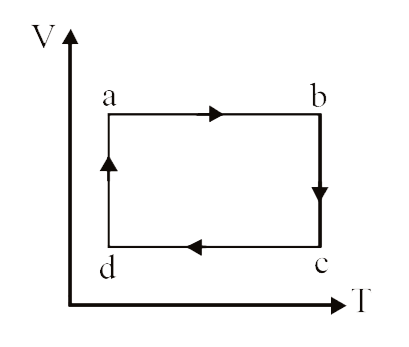In the V−T graph shown in figure:
_E01_152_Q01.png)
Column-IColumn-II(A)GasAis...andgasBis..., E is (p)monoatomic , diatomic(B)P_(A)/P_(B) is (q)diatomic , monoatomic(C)n_(A)/n_(B) is (r)gt1(s)lt1(t)cannot say any thingSolution in Gujrati
From given V−T graph we cannot tell the nature of gas slope of V−Tgraph=nRP
From graph (nRP)A>(nRP)B⇒(nP)A>(nP)B
⇒ Cannot say anything about nAnB & PAPB
Topper's Solved these Questions
- GEOMETRICAL OPTICSBOOK - ALLEN CHAPTER - GEOMETRICAL OPTICSEXERCISE - ASSERTION-REASON
40 Videos
- GEOMETRICAL OPTICSBOOK - ALLEN CHAPTER - GEOMETRICAL OPTICSEXERCISE - Comprehension Based Questions
66 Videos
- GEOMETRICAL OPTICSBOOK - ALLEN CHAPTER - GEOMETRICAL OPTICSEXERCISE - EXERCISE -02
82 Videos
- CURRENT ELECTRICITYBOOK - ALLEN CHAPTER - CURRENT ELECTRICITYEXERCISE - EX.II
66 Videos
- GRAVITATIONBOOK - ALLEN CHAPTER - GRAVITATIONEXERCISE - EXERCISE 4
9 Videos
Similar Questions
Statement-1: A real gas behaves as an ideal gas at high temperature and low pressure .
Statement-2: Liquid state of an ideal gas is impossible.
View SolutionA certain amount of ice is supplied heat at a constant rate for 7 min. For the first one minute the temperature rises uniformly with time. Then it remains constant for the next 4 min and again the temperature rises at uniform rate for the last 2 min. Given Sice=0.5cal/g∘C,Lf=80cal/g.
The initial temperature of ice is
View SolutionA triangular plate has two cavities , one square and one rectangular as shown in figure . The plate is heated.
_E01_066_Q01.png)
View SolutionIn the Bohr's model of hy drogen atom, the electron moves around the nucleus in a circular orbit of radius 5×10−11m. Its time period is 1.5×10−16s. The current associated with the electron motion is:-
View SolutionAssertion : The difference in the value of acceleration due to gravity at pole and equator is proportional to square of angular velocity of earth.
Reason : the value of acceleration due to gravity is minimum at the equator and maximum at the pole.
View SolutionFind gamma for a mixture of gases containing n_(1) moles of a monoatomic gas and n_(2) moles of a diatomic gas. Assuming diatomic molecules to be right.
View SolutionV-T graph of a process of monoatomic ideal gas is shown in figure.

Sum of work done by the gas in process abod is-
View SolutionV-T graph of a process of monoatomic ideal gas is shown in figure. Heat is supplied to the gas in process(s)-
View SolutionV-T graph of a process of monoatomic ideal gas is shown in figure. Change in internal energy of the gas is zero in process(s)-
View SolutionA mixture of n_(1) moles of monoatomic gas and n_(2) moles of diatomic gas has (C_(p))/(C_(V))=gamma=1.5
View SolutionColumnIColumnII(A)Gas A is ... and gas B is ...(p)Monoatomic, diatomic(B)pA/pBis(q)Diatomic, monoatomic(C)nA/nBis(r)>1(s)<1(t)cannot say anything
View SolutionIn the V−T graph shown in figure:
_E01_152_Q01.png)
Column-IColumn-II(A)GasAis...andgasBis..., E is (p)monoatomic , diatomic(B)P_(A)/P_(B) is (q)diatomic , monoatomic(C)n_(A)/n_(B) is (r)gt1(s)lt1(t)cannot say any thing
View SolutionThe straight lines in the figure depict the variations in temperature DeltaT as a function of the amount of heat supplied Q is different process involving the change of state of a monoatomic and a diatomic ideal gas . The initial states, ( P,V,T ) of the two gases are the same . Match the processes as described, with the straight lines in the graph as numbered. {:(,"Column-I",,"Column-II"),((A),"Isobaric process of monoatomic gas." ,(p),"1" ),((B),"Isobaric process of diatomic gas" ,(q),"2" ),((C),"Isochoric process of monoatomic gas" ,(r),"Minimum at section B"), ((D),"Isochoric process of diatomic gas" ,(s),"x-axis (i.e.'Q' axis)"):}
View SolutionMatch the following two Column - I and Column - II :
Column - IColumn - II(U)Raoult's law for volatile solute and volatile solvent(i)PA=p0A.XA(V)Raoult's law for gaseous solute and liquid solvent(ii)PAp0A+(p0B+p0A)XB(W)Raoult's law for non - volatile solute and volatile solvent(iii)p01−p1p01=n2n1+n2
View SolutionWhat is the number of degrees of freedom possessed by a molecules of (a) perfect gas (b) a monoatomic gas (c) a diatomic gas
View SolutionA mixture of n1 moles of monoatomic gas and n2 moles of diatomic gas has CPCV=γ=1.5
View Solution
